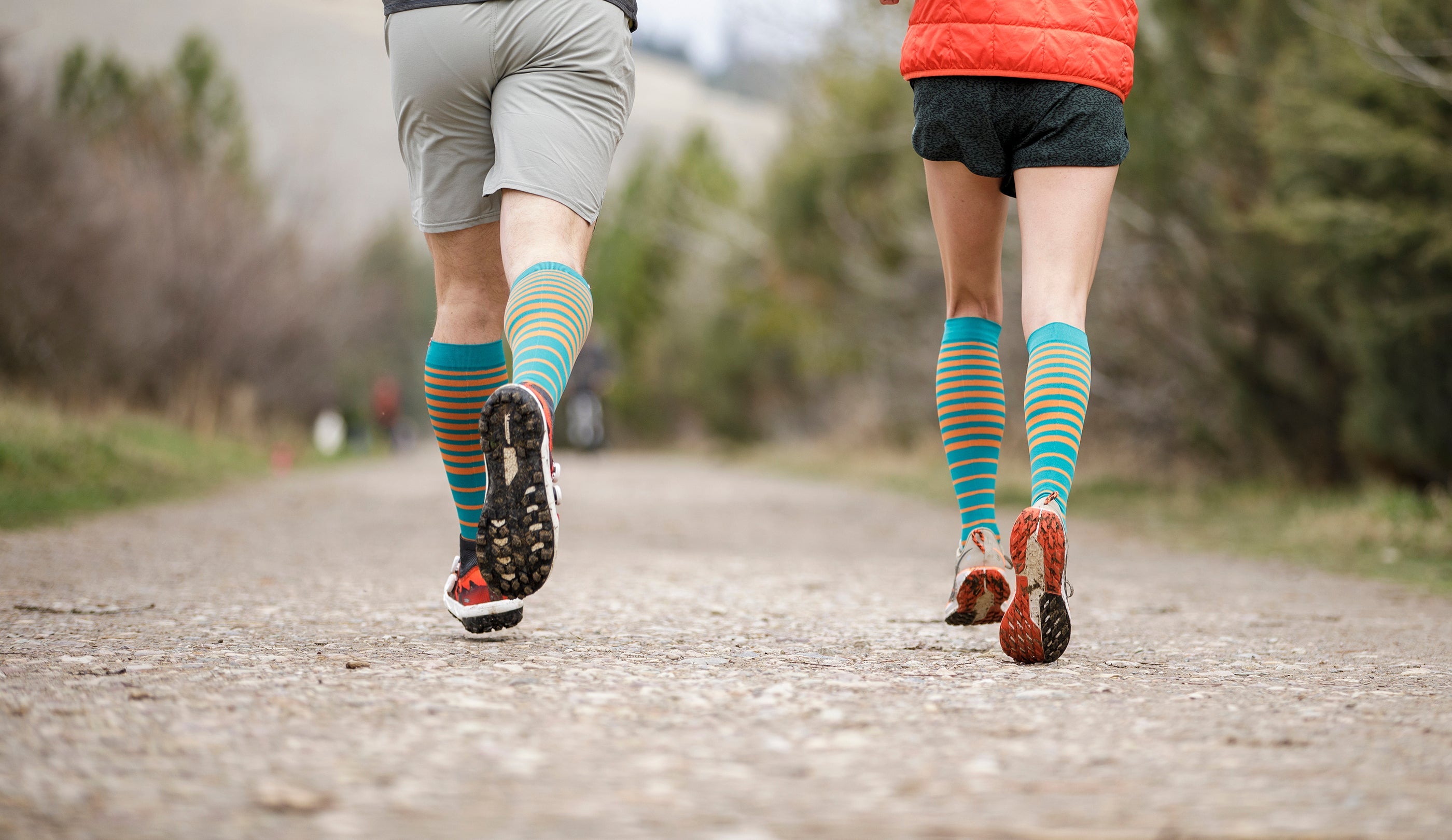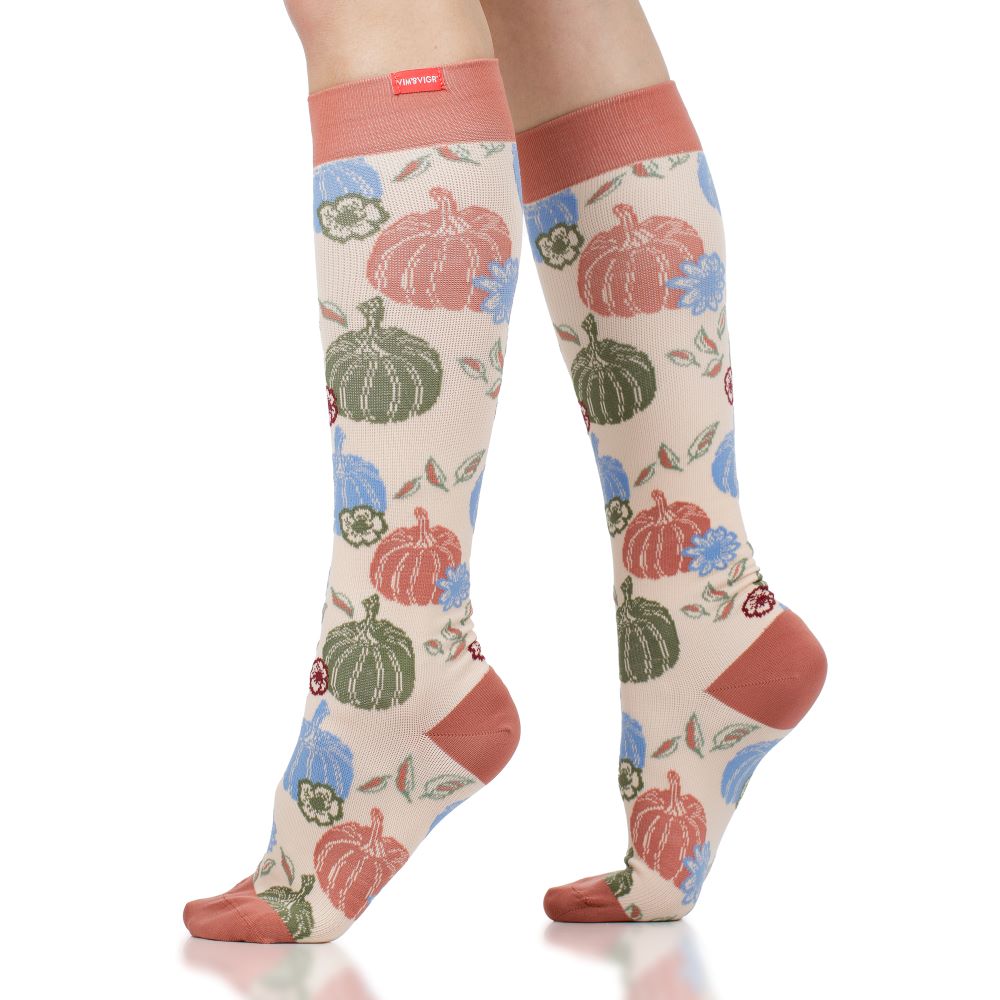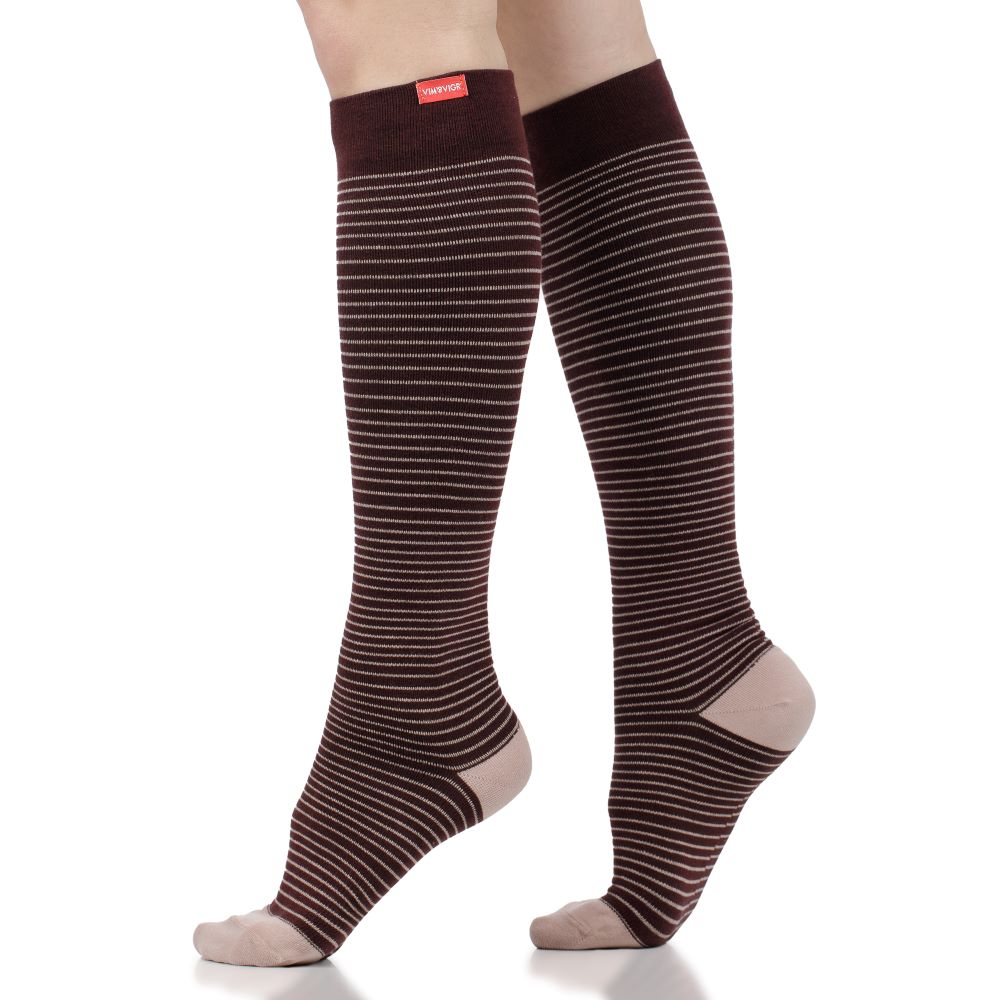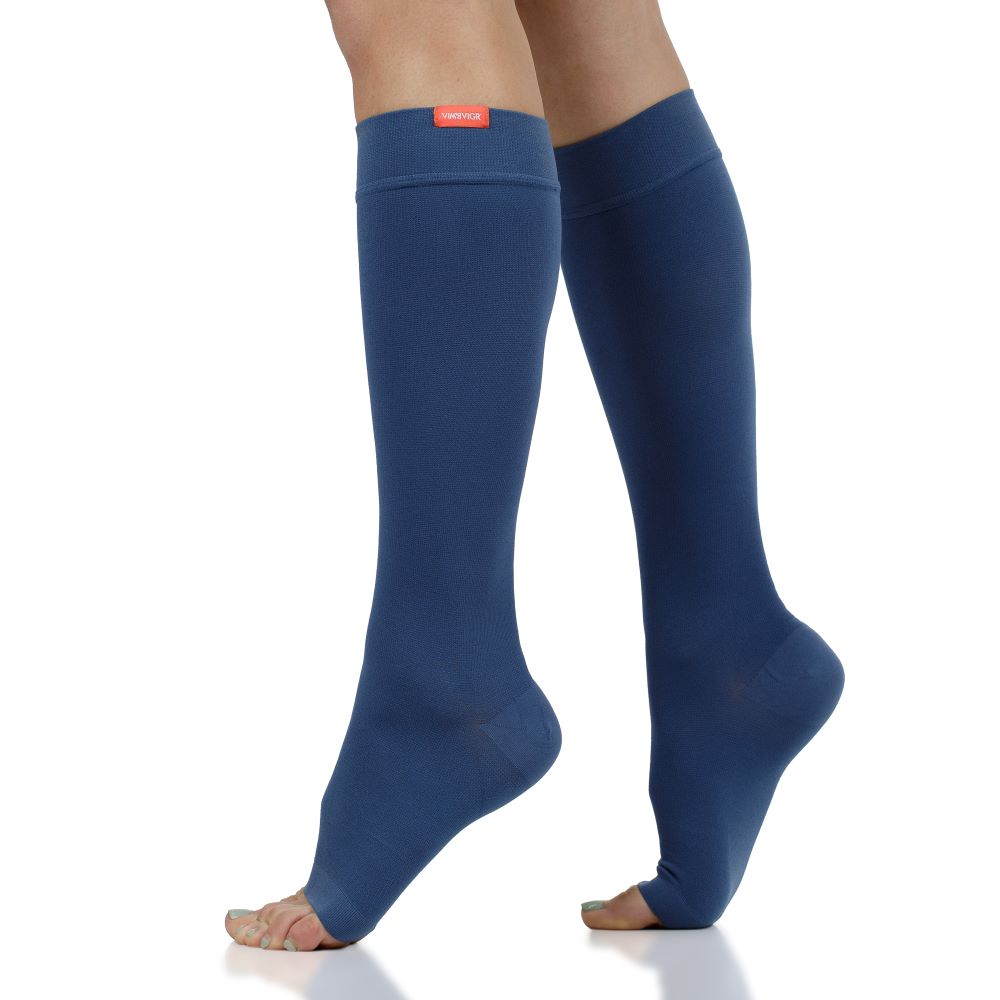How Compression Stockings Can Help with Tingling Legs and Feet
Tingling feet or legs can be a huge nuisance. Whether you suffer from a medical condition or get this feeling occasionally, it’s a sign of poor blood circulation. The good news is that there are ways to diminish these symptoms and that you can improve blood flow to the lower legs thanks to compression wear.
How can compression socks help with tingling legs and feet? Through their support of the blood flow from the lower legs back towards the heart, compression stockings and socks prevent swelling and discomfort in the lower legs, including tingling sensations.

In this article, we’ll look at:
- The causes of tingling legs and feet;
- How compression socks work to help you if you suffer from tingling lower legs;
- The benefits of compression socks in these scenarios;
- How to pick the best pair of socks or stocking for your situation.
Are Compression Stockings Good for Tingling Legs and Feet?
Since compression stockings improve the blood flow in your lower legs, they may help diminish the sensation of tingling legs and feet. Most of the time, tingling in the limbs is caused by poor blood circulation. While lifestyle changes and specific medical treatments can address this, compression is recommended by many doctors in these cases.
Graduated compression stockings are tighter at the ankle and looser towards the knee, which helps stimulate blood flow from the extremities back towards the heart. This helps reduce the risk of developing blood clots, of swelling and discomfort in the lower legs, and of tingling and “pins and needles” feelings.
Common Causes of Tingling Legs and Feet
So, what causes tingling in your legs and feet? It’s important to speak to a doctor when you start noticing symptoms, as you’ll need their help in identifying if you suffer from any of the medical conditions below.

Diabetes and Diabetic Neuropathy
Diabetes patients often experience the feeling of pins and needles, or numbness and/or pain in their feet and legs. This is caused by high blood sugar levels, which can damage your nerves and lead to diabetic neuropathy.
Compression socks improve blood circulation for diabetes and peripheral neuropathy sufferers. This can reduce the tingling sensations. They also offer added stability for the muscles in the lower legs and reduce pain and discomfort.
Multiple Sclerosis
This disease affects the central nervous system and causes information blockages between the brain and the body. Multiple sclerosis (MS) leads to damage of the myelin sheath - an insulating layer that covers the nerves. This causes muscle spasms, paralysis, and tingling or numbness throughout the body. Your legs and feet may be affected as a result.
There is currently no cure for MS, but therapy and treatments to relieve its symptoms exist. After diagnosis, your doctor can advise how to use compression stockings or socks to help improve the comfort of your lower limbs.
Hypothyroidism
When your thyroid gland doesn’t produce sufficient thyroid hormone, you may suffer from hypothyroidism, also known as underactive thyroid. Symptoms of this condition include fatigue, thinning hair, weight gain, muscle weaknesses, and painful or stiff joints. Hypothyroidism is linked with neuropathy and therefore with tingling in the legs and feet.
Nerve Impingement
This condition is caused by pressure applied to a nerve from the surrounding tissues (bones, cartilage, muscles or tendons). As a result, pain, tingling, numbness or weakness can arise in the affected area of your body. You can recover from a pinched nerve within days or weeks, but sometimes surgery can be required. In either case, compression can help relieve pain and tingling sensations.
Other Potential Causes
Tingling feet and legs can be caused by a range of other causes, including:
- Vitamin deficiencies;
- Injuries;
- Infections;
- Lupus or other auto-immune disorders;
- Kidney failure.
The causes of pins and needles in the limbs are really varied in terms of severity, which is why you should always speak to your doctor when you start encountering tingling feelings regularly.

How Compression Socks Work
Through applied pressure to the lower legs, compression socks create a massaging action on the muscles, while helping the veins push blood back towards the heart. Graduated compression socks are tighter at the ankle, releasing the pressure as they move to the knees. This is even more effective in pushing blood upwards, against gravity, when you spend a long time on your feet or sitting down.
Thanks to stimulating blood circulation, compression socks are often prescribed for reducing swelling, pain, and discomfort in the legs. They are also essential in preventing the formation of blood clots. In the case of tingling feet and legs, they can help reduce symptoms and make legs feel fresher, lighter, and more energized.
Benefits of Compression Socks for Tingling Legs and Feet
Wearing compression socks helps improve circulation, which in turn reduces the negative effects of several medical conditions. This includes trapped or pinched nerves and peripheral neuropathy.
Relieving the Symptoms of Peripheral Neuropathy
Neuropathy causes an uncomfortable feeling of “pins and needles” or tingling legs and feet. Compression stockings support blood circulation in the lower limbs, which allows the muscles to relax and reduces the risk of swelling and discomfort. Wearing compression garments at work, after a long day on your feet, or as a pre-emptive measure all helps keep the symptoms of peripheral neuropathy at bay.

Improving Circulation
Graduated compression directs blood flow from the extremities back towards the heart, ensuring that regular circulation is maintained throughout your body. Improved blood flow helps drive down inflammation, reduce swelling, and speed up recovery from harder efforts. This makes it less likely that you’ll get tingling or numbness in the legs and feet.
Reducing Tingling Associated with Nerve Impingement
Compression is known to relieve pain and discomfort associated with a pinched nerve. Wearing compression stockings provides more support and comfort to the lower limbs when there’s a pinched nerve in that part of the body. It also improves circulation.
The Best Compression Socks for Tingling Legs and Feet
Picking a pair of compression socks for tingling lower limbs doesn’t have to be difficult. You need to know your size and fabric preference and consider what compression level you’ll be comfortable with. Here are some easy steps to follow when you make your next purchase.
Size and Fit
To get the benefit from your next pair of compression socks, you need to ensure they fit well. This includes the sizing: they have to be tight enough to support blood flow, but not so tight that they make you uncomfortable (or even cut off your circulation!).
Start by measuring the circumference of your calf muscles. Then, compare that against your dress size in a table like this one to figure out your sock size.
Material
Depending on your activity and the surrounding environment, different fabrics will make your socks more comfortable. Choose cotton for everyday wear, in a variety of patterns and designs. However, on hot and humid days when you want to ensure your feet stay dry and blister-free, merino wool is your friend.
Merino wool compression socks also keep your feet warm in the cold, so they’re a good choice in winter. For tight-fitting, flexible socks, nylon is our recommendation. It’s a great material for running or dancing in, as it moves with the body seamlessly.
Compression Level
Not all compression socks are the same. In fact, when it comes to pressure levels, you can generally get three different ones:
- Moderate - the most accessible, that most off-the-shelf socks will provide; pick this for all-day-wear, without the need for a prescription;
- Firm - usually prescribed by a doctor and recommended for those suffering from varicose veins, edema, and other circulatory problems;
- Medical grade - the tightest style, available by prescription only and used for patients recovering from surgery or for bed-ridden illnesses, among other cases.
Graduated Compression vs Uniform Compression
When suffering from tingling legs and feet, it’s a good idea to pick compression socks that support your peripheral circulation as much as possible. Graduated compression garments are tighter at the extremities and looser towards the heart, which helps push blood and fluid upwards (to the heart). This can be more effective in reducing the “pins and needles” feeling, unlike uniform compression from calf sleeves, for example.
Tips to Enhance the Effectiveness of Compression for Tingling Legs and Feet
Beyond wearing compression items, you can reduce the onset of tingling legs and feet by making some lifestyle changes and following the tips below.
Maintain a Good Posture
Very often, legs and feet go numb and start to tingle because of their posture. Sitting with your legs crossed for too long, sitting on the feet, kneeling or sitting for longer periods of time, all lead to tingling and numbness.
To avoid this, switch up your posture often and ensure you stand up and go for a short walk to get some fresh air regularly throughout the day. Avoid awkward postures, such as sitting on your feet, especially for long stretches.
Avoid Prolonged Sitting or Standing
Sitting for long periods of time or standing around can also cause discomfort to the legs and feet. The gravitational pressure causes blood to pool around the ankles, leading to swelling and possibly tingling and numbness. To avoid this, you should get up regularly and even stretch a bit in between sitting periods. If you have to stand for a long time, wear comfortable shoes and compression socks, making sure you take a few regular breaks to sit and/or stretch.
Lead a Healthy Lifestyle
Since tingling in the feet and legs is most often caused by peripheral neuropathy or diabetes, ensuring you eat healthily, get plenty of exercise, and stay well hydrated should help reduce this symptom.
Additionally, tingling in the limbs can be caused by alcoholic neuropathy - damage to the nerves from excessive alcohol consumption. Reducing how much you drink can help reduce your symptoms, too.
Finally, vitamin deficiencies linked with tingling in the legs and feet include not getting enough B vitamins in your diet. B12 deficiency is linked with fatigue, digestive issues, and shortness of breath. To supplement your vitamin B intake, look to consume foods like eggs, salmon, beef, dairy, or nutritional yeast.



















Leave a comment